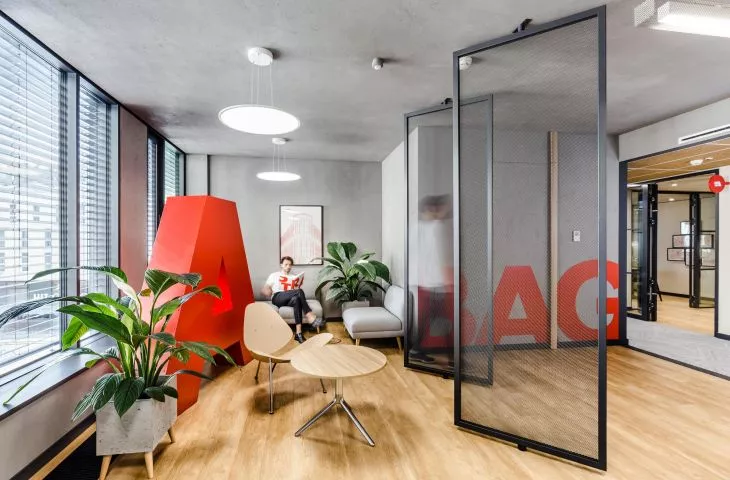Partnership, reliability and modesty were the watchwords that guided architects {tag:pracownie} in designing the interior of the STRABAG Real Estate office in Warsaw. The renovated office, located on 450 square meters, gained an open space with modern design and a clear functional layout.
Employees of STRABAG Real Estate in Warsaw have a renovated "Kraft Office" at their disposal, tailored to their needs and reflecting the brand's engineering and construction principles. The new interior was designed by the Workplace team, which specializes in creating a friendly work environment, and realized by Tétris.
Timeless materials, forms and colors
Photo: Workplace
As Michal Pyka of Workplace says of the design work:
Despite the fact that initially we were only supposed to recommend design layer solutions, after a couple of "live" design sessions it turned out that the client liked our ideas so much that he decided to have more design intervention. We developed a full concept with visual and functional arrangement, followed by guidelines for detailed design. We looked for inspiration in the company's pedigree closely related to engineering and construction, so we named the project "Kraft Office." We mapped the organization's values of partnership, solidarity, trust, modesty, reliability, among others, and translated them into materials, forms and colors that reflect the organization's character with their timelessness and elegance. It was crucial for us to make the closed layout of offices and rooms more flexible and open, so that the space became more employee-friendly and encouraged more interaction. Meeting these objectives was particularly challenging while intervening little in the existing wall layout. We accomplished this by using a large amount of glazing and rearranging the workstations.
The character of the space is given by an interesting combination of materials
Photo: Workplace
informal spaces and chillout
STRABAG Real Estate's new office now has more informal meeting spaces, and employees have gained more open areas for collaboration. In addition to workspaces, the architects also designed a chillout room for relaxation and meetings. The kitchen visually connected to the dining room allows people to drink coffee together in a comfortable and muted space. The designers also thought about the representative function of the office. The meet-and-greet style reception desk allows you to receive guests, and the layout with a hidden dressing room has resulted in an intimate place where you can quietly wait for a meeting.
Proper recycling is taken care of in the office
photo: Workplace
less waste and recycling
The architects were guided by the idea of less waste and a sustainable approach to design. Most of the furniture was refurbished, installations were not replaced, and some of the materials are recyclable, e.g. wood wool ceilings, carpets without asphalt underlays.
The effectiveness of the STRABAG office is largely based on the interesting combination of different forms of finishes. On the execution side, this involved selecting, for example, the color of laminates for already ordered furniture, preparing many samples for the client and the Workplace team to choose from. The office also had a lot of elements left over from the previous decor, under which the new elements had to be selected. Among other things, our department of electrical designers and coordinators with SIEMENS developed a lighting control system. We used existing fixtures and added new ones from another manufacturer, for which a common control had to be made. - Katarzyna Usakiewicz of Tétris tells us.
The design of the reception area
Photo: Workplace
The designers also paid a lot of attention to the right choice of materials and colors. An interesting decorative element is a free-standing letter "A" made of sheet metal, which is part of the company's name incorporated into the design of the reception space. The walls were made to measure, and the interior was complemented with aluminum and glass joinery elements in loft style. The entire reception area, including the doors, was clad in plaster imitating concrete. The result was a modern, sustainable and environmentally friendly workplace.



















































